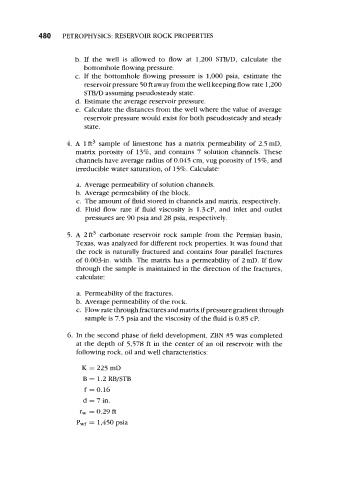Page 512 - Petrophysics
P. 512
480 PETROPHYSICS: RESERVOIR ROCK PROPERTIES
b. If the well is allowed to flow at 1,200 STB/D, calculate the
bottomhole flowing pressure.
c. If the bottomhole flowing pressure is 1,000 psia, estimate the
reservoir pressure 50 ft away from the well keeping flow rate 1,200
STB/D assuming pseudosteady state.
d. Estimate the average reservoir pressure.
e. Calculate the distances from the well where the value of average
reservoir pressure would exist for both pseudosteady and steady
state.
4. A 1 ft3 sample of limestone has a matrix permeability of 2.5 mD,
matrix porosity of 13%, and contains 7 solution channels. These
channels have average radius of 0.045 cm, vug porosity of 15%, and
irreducible water saturation, of 15%. Calculate:
a. Average permeability of solution channels.
b. Average permeability of the block.
c. The amount of fluid stored in channels and matrix, respectively.
d. Fluid flow rate if fluid viscosity is 1.3 cP, and inlet and outlet
pressures are 90 psia and 28 psia, respectively.
5. A 2ft3 carbonate reservoir rock sample from the Permian basin,
Texas, was analyzed for different rock properties. It was found that
the rock is naturally fractured and contains four parallel fractures
of 0.003-in. width. The matrix has a permeability of 2 mD. If flow
through the sample is maintained in the direction of the fractures,
calculate:
a. Permeability of the fractures.
b. Average permeability of the rock.
c. Flow rate through fractures and matrix ifpressure gradient through
sample is 7.5 psia and the viscosity of the fluid is 0.85 cP.
6. In the second phase of field development, ZBN #5 was completed
at the depth of 5,578 ft in the center of an oil reservoir with the
following rock, oil and well characteristics:
K = 225 mD
B = 1.2 RE%/STB
f = 0.16
d = 7 in.
r, = 0.29 ft
Pwf = 1,450 psia

